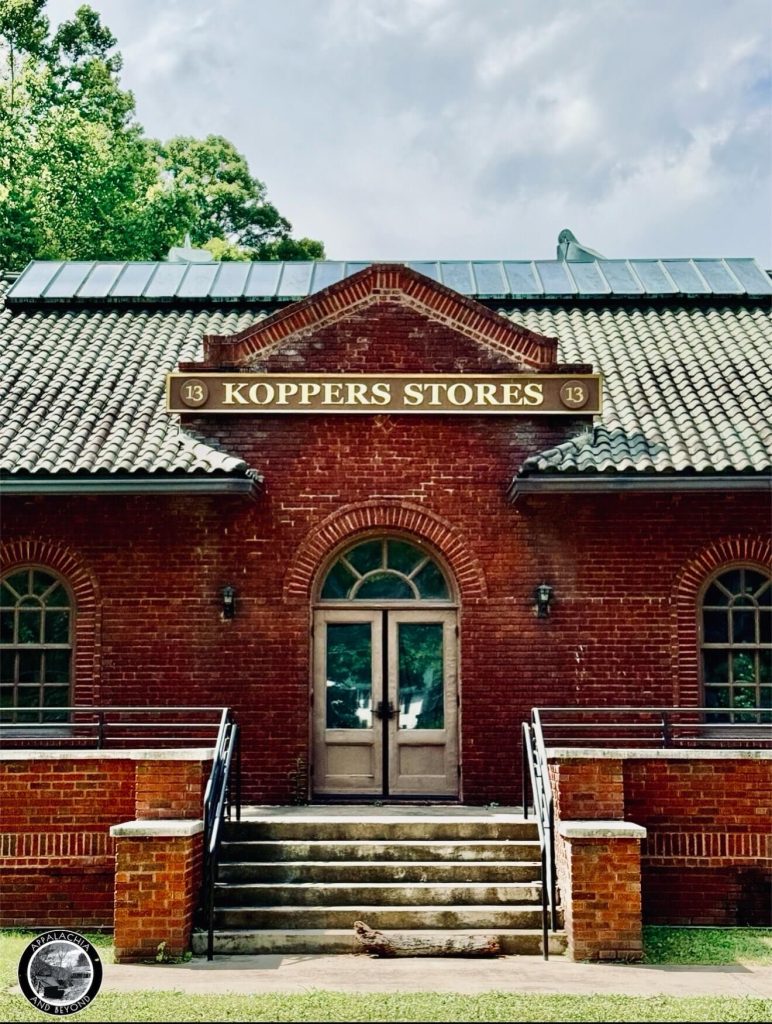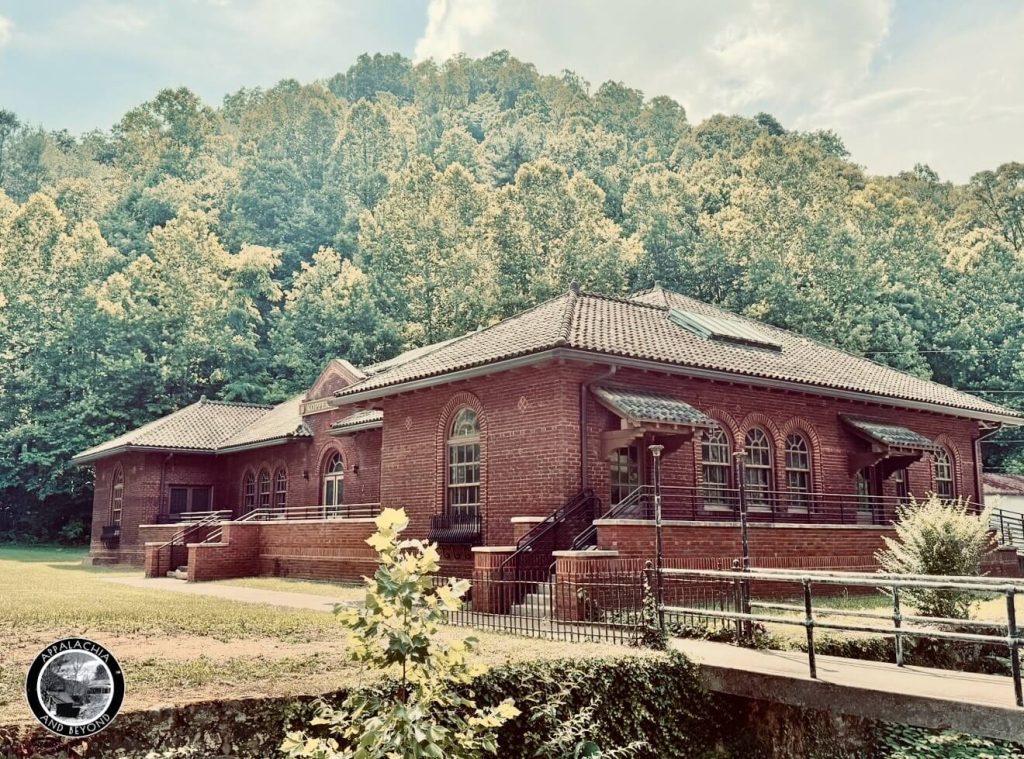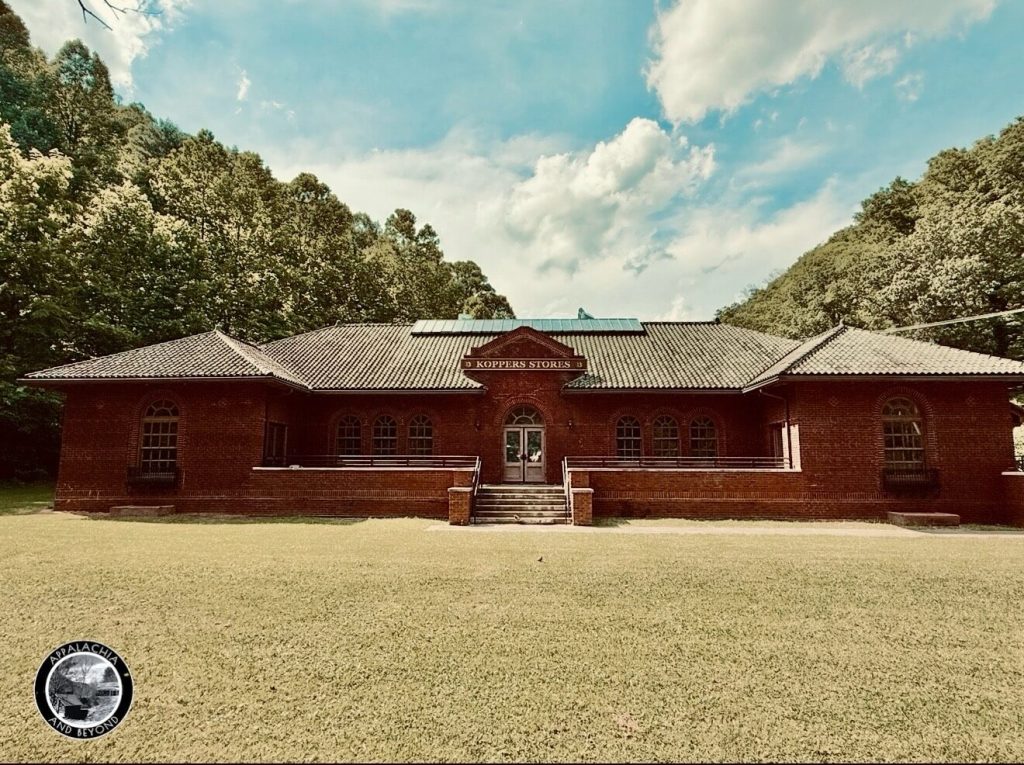Repurposed Appalachia

In a narrow hollow north of downtown Kimball sits one of McDowell County’s most intact company stores. The Houston Coal Company Store, later known to locals as the Koppers Store, anchored daily life for the Carswell mining camp and still reads clearly as an early twentieth century company showpiece.
A store at the mouth of Carswell Hollow
Built about 1923 beside today’s U.S. 52, the one story brick building presents a nine bay, perfectly symmetrical facade with round arched windows, projecting end bays, and a low pedimented doorway. A green clay tile hip roof with ridge skylights once brought daylight deep into the sales floor, while a rear arcade of arched loading doors served deliveries. The nomination drawings and photographs document an L shaped plan set within a broad lawn bordered by stone walls and a small stream.
Scholarly descriptions place the store within the Italian Renaissance revival vocabulary that swept coal country in the 1910s and 1920s, chosen to project stability and corporate pride in even the most remote hollows of the Pocahontas field. SAH Archipedia adds that the associated Houston House stands on the opposite knoll, built of similar materials and likely by the same designer.
Why company stores looked like this
In McDowell County’s coal towns the company store did far more than sell dry goods. It usually combined retail counters, post office, payroll windows, and management offices under one roof, which made the store the social and commercial center of camp life. The National Register’s countywide context for “Coal Company Stores in McDowell County” explains that operators deliberately made these buildings monumental in scale and finish to signal wealth and control, and it outlines their typical features and siting near rail sidings and mine roads.

Putting Kimball on the map
Fire insurance mapping and topographic surveys help place the Carswell store in its geographic setting. West Virginia University’s Sanborn Map collection includes a 1927 Kimball set that recorded building footprints and uses at the time. Nearby towns like Welch and Keystone survive online through Library of Congress sheets, useful for reading how coal towns organized tracks, tipples, and commercial rows along the narrow valley floors. USGS topographic quadrangles from the 1910s to 1920s further show the relationship of the store site to the Norfolk and Western mainline and Elkhorn Creek.
From Houston to Koppers
The store began as a Houston Coal and Coke Company facility. In the early 1930s the property passed to the Pittsburgh based Koppers interests, which operated “Koppers Stores” in several southern West Virginia camps. A 1929 photograph in the Norfolk and Western Historical Photograph Collection captures the Kimball Koppers Store with its long tile roof and central pediment, a valuable contemporaneous image of the building in service. Surviving Koppers Stores scrip tokens also attest to the company’s retail division and cash substitute system then common in coal towns. Corporate records for Koppers, including photographs and public relations material, are preserved at the Heinz History Center in Pittsburgh.

Daily use and memory
The McDowell County multiple property study notes that automobiles eroded the store’s monopoly during the 1920s and 1930s, yet company stores remained central places to gather and to transact wages into food, clothing, and occasional luxuries. The Houston nomination adds a useful site specific detail. Carswell’s settlement stretched far up the hollow, so the company maintained a second, smaller store upriver to serve families at the upper end while the main store at the mouth handled the heavier business.
Decline, survival, and restoration
Like many coal properties, the Houston store cycled through new owners and new uses after the mid century. Local accounts record later occupancy by a dairy, a construction firm, and county emergency services. City documentation describes stabilization work that began in the mid 2000s, including masonry repairs, new doors and windows, and reinstallation of the KOPPERS STORES sign over the entrance. In 2015 reporters covered a 1.5 million dollar effort to convert the building into a museum, an example of how coal heritage projects seek to turn surviving company landmarks into community assets.
Why it matters
The Houston Coal Company Store survives as a rare, readable example of the architecture of company power in Appalachia. Its tiled roof, arched fenestration, and generous setting were not ornamental frills. They were intended to embody a coal operator’s reach and to organize town life around a single counter, where paydays, letters, and gossip moved with equal speed. In a county that has lost many such buildings, Houston’s store still teaches how coal shaped places and habits across the southern mountains.
Sources and further reading
National Register of Historic Places nomination, Houston Coal Company Store. Prepared by Stacy Sone, WV SHPO, 1991. Architectural description, site plan, and history. West Virginia Culture Center
NRHP Multiple Property Documentation, “Coal Company Stores in McDowell County”. Context for the property type and county wide significance. NPGallery
Norfolk & Western Historical Photograph Collection. “Koppers Store, Kimball, West Virginia” (item nw1306), 1929. Virginia Tech Special Collections and University Archives. Digital Library at Virginia Tech
Sanborn Fire Insurance Maps. Welch and Keystone sheets for regional context, Library of Congress online collection; WVU finding aids confirm the Kimball 1927 set. The Library of Congress+2The Library of Congress+2
USGS Historical Topographic Map Collection. Welch quadrangles from the 1910s and 1920s available via topoView and the USGS Store. National Geological Map Database+1
Koppers Stores Division tokens. Company scrip images and metadata, Morehead State University digital collection.
Koppers Company Records. Finding aid to corporate archives, Detre Library and Archives, Heinz History Center, University of Pittsburgh. Historic Pittsburgh
SAH Archipedia. “Houston Coal Company Store and Houston House,” architectural analysis and siting. SAH ARCHIPEDIA
City of Kimball. “Houston Company Store,” local ownership timeline and restoration notes. Kimball
The Clio. “Houston Coal Company Store / Koppers Store,” curated overview with references to the NRHP file. Clio
Coal Heritage Survey Update Final Report (2018). Preservation status and trends for coal related resources in McDowell County. NPS History
Washington Times. AP style report on the planned 1.5 million dollar museum conversion. The Washington Times
Author Note: Thank you to the Instagram account @appalachia_and_beyond for generously supplying the photographs for this piece. It is one of the prettiest company stores I have seen.